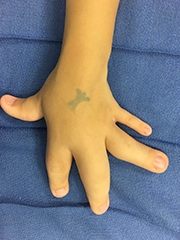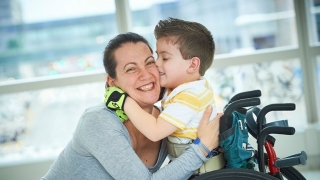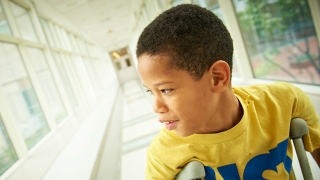Macrodactyly
What is macrodactyly?
 A child's hand with large fingers present in macrodactyly
Macrodactyly is a congenital condition in which a baby is born with abnormally large fingers or toes due to an overgrowth of the underlying bones and soft tissue. Macrodactyly occurs more often in hands than the feet. One or more fingers or toes may be involved. This condition can occur on one side only, or may affect both hands or both feet.
A child's hand with large fingers present in macrodactyly
Macrodactyly is a congenital condition in which a baby is born with abnormally large fingers or toes due to an overgrowth of the underlying bones and soft tissue. Macrodactyly occurs more often in hands than the feet. One or more fingers or toes may be involved. This condition can occur on one side only, or may affect both hands or both feet.
There are two types of growth patterns for macrodactyly:
- Static — the enlargement of the fingers or toes is present at birth, and the affected digits grow at the same pace as unaffected fingers or toes.
- Progressive — the affected fingers or toes grow at a much faster rate than unaffected digits. The affected fingers or toes can become enormous and severely impact a child’s ability to perform normal activities.
In some cases, a child’s macrodactyly-affected limb may appear to have a static growth pattern during infancy, but then can rapidly progress when the child is about 2 years old. In these cases, the affected fingers or toes grow very quickly, and often involve abnormally growth in the adjacent palm or forefoot.
Children with macrodactyly may also have other musculoskeletal differences. The most common of which is syndactyly, webbed or conjoined fingers or toes.
Though macrodactyly is a benign condition, it does cause deformities, appear cosmetically different, and may affect your child’s normal hand or foot function. Treatment for macrodactyly varies, but generally includes surgery.
Causes of macrodactyly
The cause of macrodactyly remains unknown. Researchers believe the condition is not inherited, but may instead be linked to disruptions in prenatal development.
Macrodactyly can occur in conjunction with other conditions and syndromes, including neurofibromatosis, lipofibromatous hamartoma, vascular conditions, and tuberous sclerosis complex.
Signs and symptoms of macrodactyly
The main symptom of macrodactyly is the appearance of one or more abnormally large fingers or toes. The larger digits may grow at the same rate as other non-affected fingers/toes, or have much faster growth.
Other symptoms of macrodactyly may include:
- Abnormal growth in the affected hand or foot
- Stiffness
- Difficulty moving, grasping, or using the affected hand/foot
- Swelling
- Pain (though this is rare)
Testing and diagnosis of macrodactyly
Most children are born with obvious signs of macrodactyly. Occasionally, this condition presents a bit later, when the child is a year or two old. At Children's Hospital of Philadelphia (CHOP), diagnosing macrodactyly typically begins with a physical examination of your child’s affected hand or foot. A referral to the genetics team is sometimes necessary.
In most cases, clinicians will recommend an X-ray to confirm the diagnosis. X-rays produce images of bones and help doctors identify the underlying structure of the hand or foot.
In addition to a physical exam and X-rays, your child may also undergo:
- Magnetic resonance imaging (MRI), which uses a combination of large magnets, radiofrequencies and a computer to produce detailed images of organs, soft tissues, muscles, ligaments and other structures within the body. This test can help determine which underlying tissue is enlarged. Your child is exposed to no radiation during an MRI.
- Range of motion tests to determine if the condition is affecting movement and dexterity
- Nerve assessment tests to determine if the condition has damaged or compressed any nerves
Accurate diagnosis helps us determine the best course of treatment for your child.
Treatment for macrodactyly
Treatment for macrodactyly will depend on the severity of your child’s condition, as well as the age and development of your child.
Nonsurgical interventions
If the growth of your child’s affected fingers or toes is static — meaning it is not getting worse — and is not interfering with their mobility, clinicians may recommend ongoing observation to ensure the condition doesn’t worsen.
Surgical interventions
Because macrodactyly often produces an obvious deformity and can progressively worsen, many families seek more active treatment. For the bulk of children with macrodactyly, this includes surgery.
At CHOP, fellowship-trained hand surgeons perform a variety of operations to repair bone deformities and improve function for children with hand or foot conditions.
Surgery for macrodactyly is complex and it may take several procedures to achieve the goals of halting the abnormal growth and creating a close-to-normal looking hand or foot. Your child’s doctor will discuss whether staged surgical treatment could benefit your child.
Surgery can involve debulking extra skin and subcutaneous tissue to narrow the width of the affected digits.
Epiphysiodesis could also be required when the hand bones reach adult length. In this procedure, the growth plates of individual hand bones are closed in order to prevent continued increase in length. In the most severe progressive cases, partial hand amputation may be required if all other means to control the growth of the finger(s) have been exhausted.
After surgery, your child’s affected hand or foot will be immobilized with a cast or splint.
Safety in surgery
Surgery can dramatically improve the long-term outcomes for your child with macrodactyly, but it can also be a stressful experience for you and your child.
At CHOP, we offer a wealth of resources that can help you and your child prepare for surgery. Additionally, we follow many best practices before, during and after surgery to decrease the risk of infection and increase positive outcomes. Our safety protocols have been so successful that many other institutions have adopted them.
To learn more, read how we make safety in surgery a top priority.
Follow-up care after macrodactyly treatment
Follow-up care for macrodactyly will depend on the treatment needed. If your child received nonsurgical treatment, they should be monitored regularly to ensure the condition does not begin to significantly affect their daily activities.
If your child needs surgery, they will be examined a few times in the first 2 to 3 months after surgery, and then every 6 to 12 months to monitor function and continued growth.
Additional operations will be performed as needed. Your child’s doctor will give you specific information about a recovery program for your child and how soon they can return to daily activities.
Outlook
The long-term outlook for children treated for macrodactyly is generally good. In most cases, surgery can control hand growth, improve hand function, and help children better manage their daily activities.
Reviewed by Apurva S. Shah, MD, MBA

